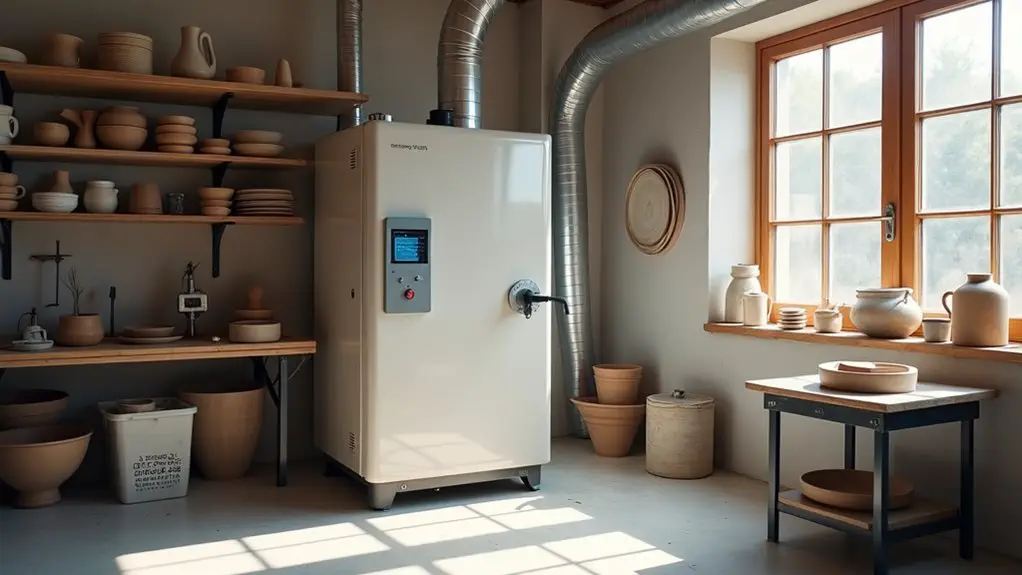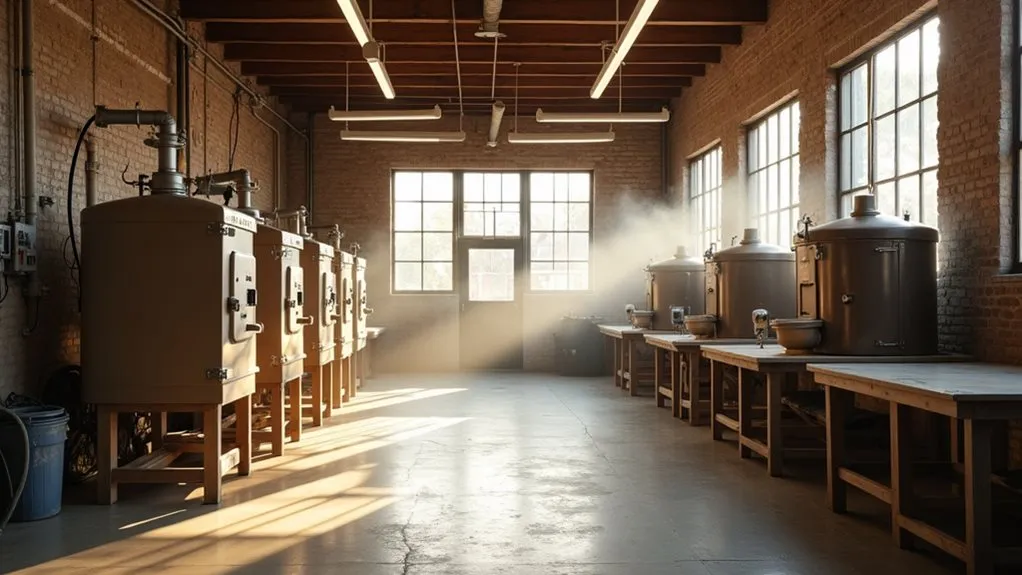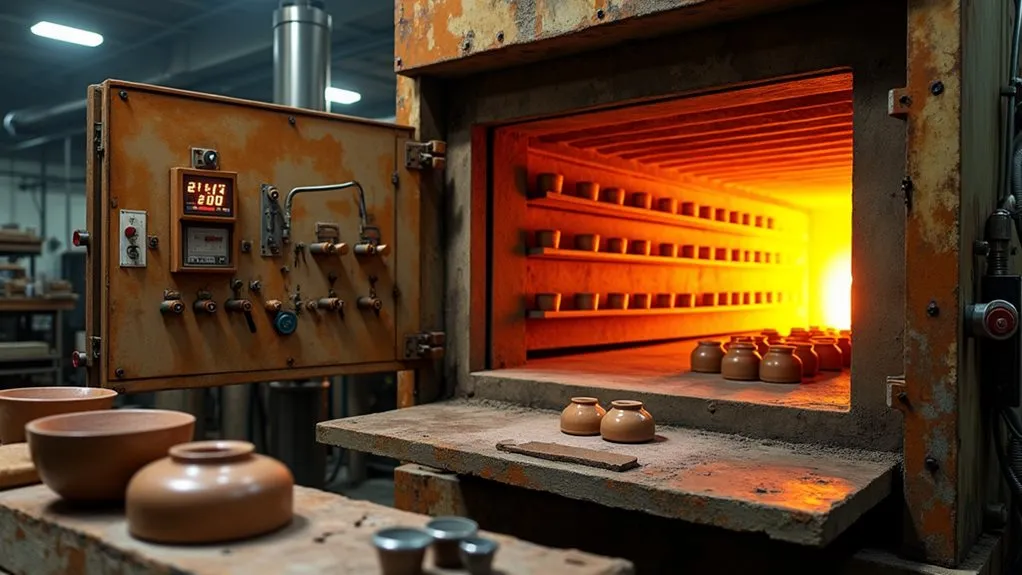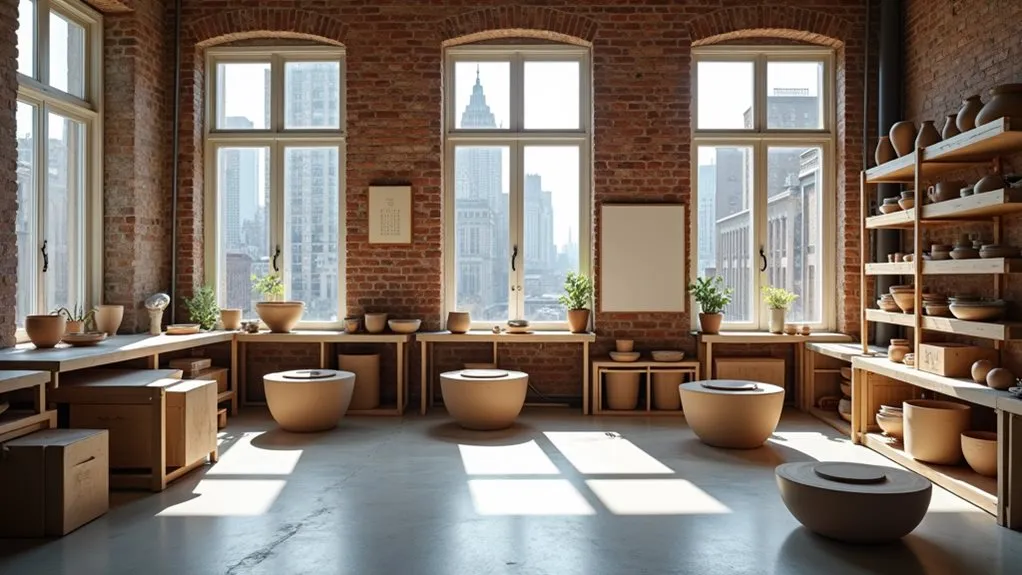Pottery classes aren’t cheap because you’re paying for several essential components that make the experience possible. You’ll need access to expensive equipment like kilns (£1,500-£5,000) and pottery wheels (£400-£2,000), plus high-quality materials including clay and glazes. Expert instructors, who typically earn £50+ per hour, provide invaluable guidance and knowledge developed over years of practice. The small class sizes guarantee you get personalized attention, while dedicated studio space with utilities and maintenance adds to overhead costs. Studios must balance these expenses while keeping classes accessible, but there’s much more to the pricing puzzle than meets the eye.
The Real Cost of Equipment

Ever wondered what makes pottery classes so expensive? A major factor lies in the hefty equipment costs that studios must invest in before they can even open their doors. You’re not just paying for a lump of clay – you’re getting access to thousands of dollars worth of specialized tools and machinery.
Let’s break it down: A professional pottery studio needs at least one high-quality kiln, which can cost anywhere from £1,500 to £5,000. Then there’s the pottery wheel situation – and we’re not talking about that romantic scene from “Ghost.” Quality electric wheels, which you’ll find in most studios, range from £400 to £2,000 each. Studios typically need multiple wheels to accommodate several students. Monthly electricity costs for kilns can add another £50 to operating expenses.
But that’s just the big stuff! Don’t forget about all those smaller tools you’ll be using: kiln furniture, throwing tools, brushes, and drying racks. These might seem like minor expenses, but they add up quickly.
When you factor in the studio’s overhead costs like rent, utilities, and maintenance, you’ll understand why your local pottery studio isn’t exactly giving those classes away!
High-Quality Materials Add Up
Quality comes at a price in pottery, and materials represent a significant portion of your class costs. When you’re diving into ceramics, you’ll quickly discover that clay, glazes, and tools aren’t just basic supplies – they’re investments in your artistic journey. A single 25-pound bag of clay might set you back £15 to £50, and that’s just the beginning! Joining a community pottery studio can help offset some of these material expenses.
The materials you’ll need typically include:
- High-quality clay suited to your project type
- Various glazes for different effects and finishes
- Underglazes for detailed decorative work
- Essential tools like fettling knives and shaping tools
- Specialized materials for specific techniques
You’ll find that most studios charge an initial materials fee (around £40) to get you started, but don’t be surprised if you need to restock as you progress.
While these costs might seem steep at first, they’re actually helping you develop your skills. Think of it this way: each piece you create is a learning experience, and as you improve, you’ll waste less material and work more efficiently.
It’s like investing in your own creative growth – totally worth it!
Studio Space and Utilities

A pottery studio’s overhead costs can greatly impact class prices. When you’re taking classes, you’re not just paying for the instruction – you’re also contributing to the substantial costs of running the space.
Studios in urban areas can command monthly rents between £1,500 and £5,000, and that’s before anyone even touches a piece of clay! Looking at comparable creative spaces, flat rate rentals for similar-sized studios can cost up to £680 for just 8 hours of use.
Think about all the utilities needed to keep those wheels spinning and kilns firing. Studios typically rack up £200 to £800 monthly in electricity, water, and gas bills. That’s a lot of power needed to transform your lumpy clay into beautiful ceramics!
The space itself needs regular maintenance too, with annual repair costs running from £1,000 to £5,000 – because nobody wants a wonky pottery wheel or a temperamental kiln during class.
And let’s not forget about those essential licenses and permits that keep everything legal and running smoothly. These can add hundreds or even thousands to the studio’s expenses.
When you factor in property insurance and the ongoing costs of maintaining a safe, clean environment for students, you’ll understand why these overhead costs are reflected in your class fees.
Expert Instructor Compensation
You’ll find that highly skilled pottery instructors often command premium rates of £50 or more per hour, reflecting their expertise and teaching abilities.
Your instructor’s years of experience directly influence the cost of your pottery classes, as studios typically pay more for teachers who’ve mastered both the technical and educational aspects of ceramics.
When you’re learning from an expert with extensive teaching experience, you’re not just paying for their time – you’re investing in their accumulated knowledge, proven teaching methods, and ability to guide students effectively through complex techniques.
Many pottery instructors receive 50% of workshop fees, which helps ensure they’re fairly compensated while staying motivated to deliver quality instruction.
Skills Command Premium Rates
Skilled pottery instructors consistently command premium rates due to their specialized expertise and advanced techniques. You’ll find that many experienced instructors can earn £100 or more per day, especially when teaching specialized workshops or private sessions. These higher rates reflect years of practice, deep knowledge of ceramics, and the ability to guide students through complex techniques. On average in America net profits exceed $130 for a two-hour couples class after accounting for all expenses.
When you’re learning from an expert instructor, you’re not just paying for their time – you’re investing in their valuable knowledge and experience.
Here’s what makes their premium rates worth it:
- Mastery of advanced throwing and hand-building techniques
- Deep understanding of glazing and firing processes
- Ability to troubleshoot common pottery challenges
- Experience with specialized equipment and tools
- Knowledge of safety protocols and best practices
As you progress in your pottery journey, you’ll notice that different instructors charge varying rates based on their expertise level.
While community studios might offer basic classes at £20-30 per hour, specialized instructors often command higher fees, particularly for private lessons or advanced workshops.
These rates reflect not just their teaching time, but also their preparation, material knowledge, and years of experience perfecting their craft.
Teaching Experience Drives Cost
Teaching experience greatly influences pottery instructor compensation, with rates varying from £20 to £50 per hour based on expertise level.
You’ll find that most studios offer either hourly rates or a percentage-based system, where instructors receive up to 50% of collected workshop fees. When you’re taking classes from highly experienced instructors, you’re not just paying for their teaching time – you’re also covering their preparation, travel, and material organization.
The investment in experienced instructors becomes clear when you look at the numbers. While newer teachers might start at £20 per hour, seasoned professionals with advanced degrees can command much higher rates, with some earning over £60,000 annually. With female instructors dominating at nearly 70% of teaching positions, the field shows strong representation in ceramic arts education.
Curiously, education plays a huge role – instructors with doctorates typically earn around £57,000 yearly. You’re also paying for their years of dedication, as only 7% of pottery teachers have more than eleven years of experience.
It’s worth noting that these experienced instructors bring invaluable knowledge to your learning journey, making the higher cost of their classes a worthwhile investment in your pottery education.
Kiln Operations and Maintenance

Kilns serve as the heart of any pottery studio, requiring specialized knowledge and careful attention to operate safely and effectively. When you’re paying for pottery classes, you’re not just covering the cost of clay and instruction – you’re also investing in the complex world of kiln operations and maintenance that brings your creations to life.
Here’s what goes into keeping a kiln running smoothly:
- High-powered electrical systems that need specialized outlets and regular inspections
- Precise temperature control systems for different clay bodies and glazes
- Regular cleaning and maintenance to prevent firing issues
- Safety protocols and ventilation systems to protect everyone in the studio
- Specialized kiln furniture and equipment that needs constant upkeep
You might be surprised to learn that running a kiln isn’t as simple as pressing a button and walking away. It’s more like conducting a ceramic symphony, where timing, temperature, and technique must work together perfectly. The studio’s electric and gas kilns are equipped to handle both Cone 6 and Cone 10 pieces, adding to operational complexity and costs.
When you’re wondering why pottery classes aren’t cheaper, remember that kiln operation costs include not just the electricity and maintenance, but also the expertise needed to guarantee your pieces come out exactly as you’ve envisioned them.
Small Class Size Benefits
You’ll love the personalized attention you get in a small pottery class, where instructors can guide your hands as you learn wheel-throwing techniques and help you perfect your glazing skills.
Having fewer students in the studio means you’ll always have enough space to work safely with the equipment and access to all the tools you need. Active participation in small pottery classes helps develop your creative problem-solving abilities.
The intimate class setting creates a comfortable environment where you can ask questions freely and build confidence in your pottery-making abilities, without feeling overwhelmed or rushed.
Individual Attention Maximized
In our pottery classes, you’ll experience the significant advantages of small class sizes, where individual attention takes center stage.
Just as experienced teachers facilitate learning in successful educational environments, our instructors guide you toward discovering your unique artistic voice.
You’ll find yourself in an environment that’s specifically designed to help you thrive, with instructors who can dedicate quality time to your artistic journey. We’ve structured our classes to guarantee you’re never just another face in the crowd.
Here’s what you can expect from our intimate class setting:
- Direct, hands-on guidance as you master wheel throwing techniques
- Immediate feedback on your form and technique while you work
- Personalized tips tailored to your unique learning style
- Extra time with tools and equipment when you need it
- One-on-one troubleshooting for challenging projects
With fewer students in each class, you’ll develop a stronger connection with both your instructor and fellow pottery enthusiasts.
You won’t have to wait long for help when you’re stuck on a difficult technique, and you’ll receive the focused attention needed to improve your skills quickly.
This personalized approach means you’ll progress faster and develop proper techniques from the start, avoiding common mistakes that could hold back your pottery journey.
Safe Learning Environment
Safety flourishes in our small pottery classes, where a nurturing environment helps students explore their creativity without hesitation.
Research shows that students achieve 30% more participation in smaller class settings. You’ll notice the difference right away when you’re in a smaller setting – it’s easier to feel comfortable, ask questions, and really engage in learning pottery techniques. Whether you’re naturally shy or outgoing, you’ll find your voice in our intimate classroom environment.
In these smaller classes, you’ll have plenty of space to work on your projects while building meaningful connections with fellow pottery enthusiasts.
You won’t feel overwhelmed or rushed as you practice throwing clay or glazing techniques. Instead, you’ll experience a supportive atmosphere where everyone’s learning journey is valued and respected. The reduced class size means you’re never too far from help when you need it, and there’s always room to experiment safely with new methods.
Best of all, you’ll develop genuine friendships with your classmates as you share experiences and learn from each other.
There’s something special about creating art in a space where you feel truly supported and understood.
Location Impacts Pricing

Location plays a pivotal role in determining pottery class prices across different regions. You’ll find that urban studios typically charge more than rural ones, with prices ranging from £30 to £50 per hour in city centers.
This isn’t just because city folks have deeper pockets – it’s actually due to higher operating costs and rent that studios need to cover. Most studios allocate 30% to 50% of their revenue just to cover these fixed costs.
When you’re looking at pottery class prices, you’ll notice they vary based on several location-specific factors:
- Studio rent and utility costs in the area
- Local competition and market demand
- Cost of living in the neighborhood
- Available studio space and facilities
- Local instructor rates and expertise
You’re not just paying for the class itself – you’re investing in the entire experience that comes with your studio’s location.
If you’re taking classes in a trendy downtown art district, you’ll likely pay more than at a countryside studio.
But don’t let higher prices scare you away! Many urban studios offset costs by offering membership options or group discounts.
Plus, they often provide additional perks like extended studio hours or access to premium equipment that you won’t find in smaller locations.
Behind the Glazing Process
Every ceramic masterpiece requires a careful glazing process that transforms raw clay into stunning, durable art. You’ll find that glazing isn’t just about dipping a pot in some colorful liquid – it’s a complex dance of chemistry and technique that’ll make or break your piece.
When you’re in a pottery class, you’re not just paying for the glaze itself but for the expertise that goes into its application. Your instructor knows exactly how to blend silica, alumina, and various fluxes to create the perfect coating, and they’ll teach you the tricks of proper application. Each clay body interacts uniquely with glazes to produce distinctive outcomes.
Whether you’re learning to dip, pour, brush, or spray, each technique requires practice and precision to achieve those beautiful results you’re hoping for.
The process doesn’t end with application, either. Your piece needs careful drying time, and then there’s the vital firing process where temperatures must be precisely controlled.
It’s during this stage that those stunning colors develop and the glaze transforms into that glass-like finish you’re dreaming of. Sure, it’s technical, but that’s exactly why you’re learning from pros who understand the science behind the art.
Final Thoughts
So you’ve discovered that pottery’s not just playing with mud – it’s an investment in artistry, equipment, and expertise. While you might need to break open that piggy bank to attend classes, you’re paying for a craft that’s survived millennia. Remember, you’re not just learning to make wonky bowls; you’re joining an ancient tradition of turning earth into art (even if your first attempts look more prehistoric than professional).




